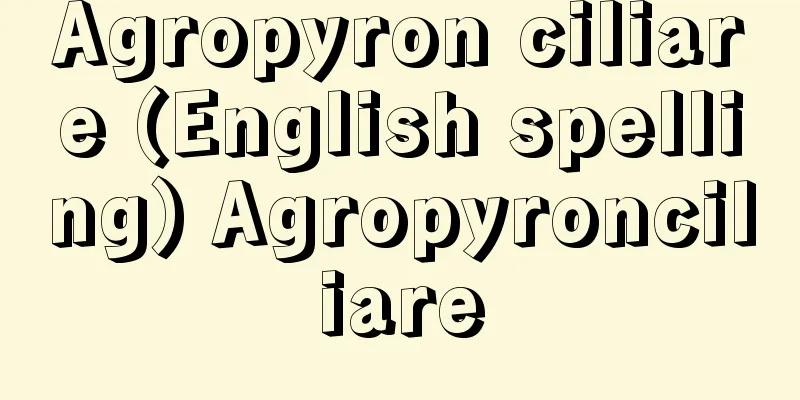Persian literature

|
In a broad sense, it refers to literature written in Old Persian, Medieval Persian (Pahlavi), and Early Modern Persian, but generally it refers to literature written in Early Modern Persian written in Arabic script during the Islamic period. Ancient literature includes the Zoroastrian holy book "Avesta" written in Avestan, compiled during the Sassanid period, and inscriptions in Old Persian. For details on Pahlavi literature, please refer to the relevant article ("Pahlavi literature"). The following is the historical development and characteristics of early modern Persian literature. [Tsuneo Kuroyanagi] Two Centuries of SilenceAfter the Sassanid Empire was defeated by Islamic Arab armies in the mid-7th century, Iran came under direct Arab rule, a state that continued for two centuries until the mid-9th century. During this time, Arabic was used as the administrative and academic language, and Modern Persian emerged to replace Medieval Persian, but in reality it was only used as a spoken language. Iranian scholars therefore wrote in Arabic, making a major contribution to the formation of Islamic culture, but there are no documents written in Persian at all. This period, when Iran lost its political and linguistic independence, is known as the "Two Silent Centuries." [Tsuneo Kuroyanagi] The early daysAround the middle of the 9th century, as Arab control weakened and the Islamization of Iran strengthened, a series of local but national dynasties were established in Iran. Persian poets began to appear in these courts, and it is said that several poets were active, but only fragmentary poems remain. However, it is true that the 9th century was the dawn of Persian literature. [Tsuneo Kuroyanagi] Persian Literary RenaissanceThe ethnic dynasty Samanid, whose capital was Bukhara from the end of the 9th century to the end of the 10th century, ruled over Central Asia and eastern Iran, and implemented a policy of promoting ethnic culture. As a result of their efforts to protect and encourage Persian poets, Persian literature flourished greatly and entered a period of literary revival. The literature of this period was characterized by odes, the literature of the court nobility, and national epics based on national consciousness, and great poets appeared in each field. Representative figures are Rudaki, the father of Persian poets, and Firdousi, the great national poet. During this period, the foundations of the Khorasan style, which would become the mainstream of classical Persian poetry, were laid. [Tsuneo Kuroyanagi] Classical Golden Age 11th to 15th centuryFrom the 11th century to the end of the 15th century, Iran was ruled by foreign ethnic groups such as Turks and Mongols, but these ruling classes were assimilated into Iranian culture and protected Persian poets, which led to the further flourishing of Persian literature. It is said that as many as 400 court poets served at the court of Ghaznavid Sultan Mahmud in the first half of the 11th century, and three great poets, including Unsuri, were active in the field of anthems and established the Khorasan style. Persian literature and Iranian culture reached their peak during the Seljuk and Atabeg dynasties from the second half of the 11th century to the first half of the 13th century, and the field of Persian poetry became much richer in content than ever before. The distinctive feature of this period was the notable activities of Seljuk court poets such as Anwari and Muizzi, as well as court poets from local dynasties, and mysticism was introduced, with the two great mystical poets Sana'i and Attar laying the foundations of this field. Compared to the simple expressions of the Samanid period, this period saw the use of a large amount of Arabic vocabulary and a more ornate style of writing, a major feature of the period. It was during this period that Umar al-Khayami, the poet of the Rubaiyat, was active. Around the 10th century, Persian poetry was limited to Central Asia and eastern Iran, but during this period Persian poets emerged throughout Iran. In particular, in the western Azerbaijan region, outstanding poets such as Khaqani and Nizami wrote poetry in the Iraqi style as opposed to the Khorasan style. Persian prose, the foundations of which were laid in the 10th century along with poetry, also flourished during this period, producing notable works across a wide range of fields. From the late 13th century to the early 14th century, Persian literature temporarily stagnated due to the invasion and rule of the Mongol army, but it later recovered, and in the 13th century two great poets, Rumi and Saadi, appeared, producing several excellent works in the field of history. From the late 14th century to the end of the 15th century, during the Timurid dynasty, Persian literature gradually declined. However, in the 14th century, Hafez, known as the greatest lyric poet, appeared, and in the 15th century culture flourished, centering on the Herat court, and the great poet Jami, worthy of marking the end of the classical era, was active in the field of mysticism, and in prose, history books and biographies of poets were written. [Tsuneo Kuroyanagi] DeclineWhen the national dynasty, the Safavid dynasty, was founded in the 16th century, Shiiteism was made the state religion and Persian literature flourished not only in politics but also in the fields of art and crafts, but Persian literature rapidly declined as it did not fit with the policies of the dynasty, and this stagnation continued until the end of the 18th century. During this time, the Mughal court in India became the center of Persian poetry, and many Iranian poets immigrated to India, leading to the creation of poetry in the Indian style, which also had an influence in Iran. [Tsuneo Kuroyanagi] Modern and contemporary literatureDuring the 19th century Qajar dynasty, the tradition of Persian poetry was revived by court poets such as Qa'ani, and poetry was written in a classical style. From the middle of the 19th century, Western ideas and literature were gradually introduced, and especially during the constitutional revolution movement from the end of the 19th century to the beginning of the 20th century, many newspapers were published and enlightenment literature became popular. After that, the foundations of novels were laid by Jamal Zadeh and Hedayat, and calls were made to popularize literature by making full use of slang, and many works appeared on the theme of the lower classes of society. In the field of poetry, after the traditional classical style of poetry by the patriotic poet Bahar and the female poet Parveen, free verse by Yusiji began to attract attention. The study of classical literature was also a major feature of the 20th century. After the Iranian Islamic Revolution of 1979, many poems celebrating the revolution and religious documents related to Islam appeared, but notable literary works have yet to appear. [Tsuneo Kuroyanagi] "Persian Literary Thoughts by Tsuneo Kuroyanagi (1977, Kondo Publishing)" [Reference item] |Source: Shogakukan Encyclopedia Nipponica About Encyclopedia Nipponica Information | Legend |
|
広義では古代ペルシア語、中世ペルシア語(パフラビー語)、近世ペルシア語による文学を意味するが、一般にはイスラム期におけるアラビア文字で表記される近世ペルシア語による文学をさす。古代の文献としてはササン朝時代に編纂(へんさん)されたアベスタ語によるゾロアスター教聖典『アベスタ』と古代ペルシア語の碑文などがある。 パフラビー文学については当該項目(「パフラビー文学」)を参照されたい。次に述べるのは近世ペルシア文学の歴史的展開と特色である。 [黒柳恒男] 沈黙の2世紀7世紀のなかばにイスラム・アラブ軍に攻略されてササン朝が滅亡すると、イランはアラブの直接支配下に置かれ、9世紀なかばまで2世紀にわたりこの状態が続いた。この間アラビア語が行政語、学術語として用いられ、中世ペルシア語にとってかわって近世ペルシア語が生まれるが、これは実際には話しことばとして用いられたにすぎない。そこでイラン人学者たちもアラビア語で執筆し、イスラム文化形成に大きく貢献したが、ペルシア語による文献はいっさいない。政治的、言語的に独立性を失ったこの時代は「沈黙の2世紀」とよばれる。 [黒柳恒男] 黎明期アラブの支配力が弱まり、イランのイスラム化が強化された9世紀なかばごろから、イランに地方王朝ながら民族王朝が相次いで樹立された。それら宮廷にペルシア詩人が現れ始め、幾たりかの詩人が活躍したと伝えられるが、断片的な詩が現存するだけである。しかし9世紀がペルシア文学の黎明(れいめい)期であったことは事実である。 [黒柳恒男] ペルシア文芸復興9世紀末から10世紀末までブハラに首都を置き、中央アジア、東部イランを支配した民族王朝サーマーン朝は民族文化振興政策をとった。そしてペルシア詩人の保護奨励に努めたためペルシア文学は非常に栄え文芸復興期を迎える。この時代の文学の特色は宮廷貴族文学としての頌詩(しょうし)と民族意識に基づく民族叙事詩で、それぞれの分野に大詩人が現れた。ペルシア詩人の父ルーダキーと大民族詩人フィルドウスィーがその代表的存在である。この時代、ペルシア古典詩の主流を形成するホラサーン・スタイルの基礎が築かれた。 [黒柳恒男] 古典黄金時代 11~15世紀11世紀以降15世紀末まで長年月にわたりイランはトルコ系、モンゴル系など異民族に支配されたが、これら支配層はイラン文化に同化され、ペルシア詩人を保護したので、ペルシア文学はますます隆盛した。11世紀前半ガズナ朝スルタン、マフムードの宮廷には400人もの宮廷詩人が仕えたと伝えられ、ウンスリーをはじめ三大詩人が頌詩の分野で活躍し、ホラサーン・スタイルを確立した。11世紀後半から13世紀前半におけるセルジューク朝、アターベク諸王朝の時代にペルシア文学、イラン文化は最盛期を迎え、ペルシア詩の領域は内容面で従来以上にはるかに豊かになった。この時代の特色として、アンワリー、ムイッズィーらセルジューク朝宮廷詩人のほか、地方王朝の宮廷詩人の活躍が顕著で、神秘主義が導入され、サナーイー、アッタールの二大神秘主義詩人がこの分野の基礎を築いた。サーマーン朝時代の素朴な表現に比べて、この時代には多くのアラビア語彙(ごい)が用いられ、文体が華麗になったのが大きな特色といえる。『ルバイヤート』の詩人ウマル・アル・ハイヤーミーが活躍したのもこの時代である。10世紀ごろ、ペルシア詩は中央アジアと東部イランに限られていたが、この時代にはイラン全域にわたってペルシア詩人が輩出。とくに西部のアゼルバイジャン地方ではハーカーニー、ニザーミーら優れた詩人により、ホラサーン・スタイルに対してイラク・スタイルによる詩作が行われた。 10世紀に詩とともに基礎が築かれたペルシア散文学も、この時代に隆盛期を迎え、さまざまな分野にわたり注目すべき作品が生まれた。13世紀後半から14世紀前半にかけてモンゴル軍の侵入、支配により一時的にペルシア文学は停滞するが、その後復活し、13世紀には二大詩人ルーミー、サーディーが現れ、歴史の分野でいくつかの優れた作品が数えられる。14世紀後半から15世紀末にかけてティームール朝時代にペルシア文学はしだいに衰えをみせる。しかし14世紀には最高の叙情詩人とうたわれるハーフィズが現れ、15世紀にはヘラート宮廷を中心に文化が栄え、古典時代の最後を飾るにふさわしい大詩人ジャーミーが神秘主義の分野で活躍、散文においても歴史書、詩人伝などが執筆された。 [黒柳恒男] 衰退時代16世紀、国民王朝サファビー朝が創設されると、シーア派を国教に制定、政治面のみならず美術工芸の分野で栄えたが、ペルシア文学は王朝の政策とかみ合わず急速に衰退、この沈滞が18世紀末まで続いた。この間、インドのムガル朝宮廷がペルシア詩の中心となり、イランの詩人でインドに移住する者が続出、インド・スタイルという作風で作詩が行われるようになり、イランにも影響を及ぼした。 [黒柳恒男] 近・現代文学19世紀カージャール朝の時代にカーアーニーら宮廷詩人によるペルシア詩の伝統が復活し、古典スタイルによる作詩が行われた。19世紀なかばからしだいに西欧思想、文学が導入され、とくに19世紀末から20世紀初頭の立憲革命運動時代には新聞が多く刊行され、啓蒙(けいもう)文学が盛んになった。その後ジャマール・ザーデ、ヘダーヤトらによって小説の基礎が築かれ、俗語を駆使した文学大衆化が叫ばれ、社会の下層階級をテーマとした多くの作品が現れた。詩の分野では愛国詩人バハール、女流詩人パルビーンらによる伝統的な古典詩スタイルを経て、ユーシージによる自由詩が注目を浴びるようになった。古典文学研究も20世紀の大きな特色である。1979年のイラン・イスラム革命後は革命を謳歌(おうか)した詩、イスラムに関する宗教文献が多く現れたが、注目すべき文学作品はまだ現れていない。 [黒柳恒男] 『黒柳恒男著『ペルシア文芸思潮』(1977・近藤出版社)』 [参照項目] |出典 小学館 日本大百科全書(ニッポニカ)日本大百科全書(ニッポニカ)について 情報 | 凡例 |
<<: Persian calendar - Persian calendar
>>: Persian cat - Perushianeko (English spelling) Persian cat
Recommend
Valencia Orange
The Valencia orange is a representative variety of...
Albania - Albania (English spelling)
A republic located in southeastern Europe, in the...
Masuyama - Station
A city developed in the Mangyeong River basin in t...
Pigment printing - Ganryo Nassen
A printing method in which pigments are mixed with...
Gentaro Eguchi
...The name was coined in response to the fact th...
Calcination (English spelling)
A method of obtaining oxides by heating metal hydr...
Afar Ape Man - Afar Engine
⇒ Australopithecus afarensis Source: About Shogaku...
arrow-poison frog
...A type of frog that secretes a strong poison f...
Imperial Decree - Choku
Along with the Imperial Sacred Written Document (...
Bahnsen, J.
… Later, with the advancement of physiology, the ...
Guter, CA - Guter
…Usually, the instrument is held by holding the c...
Upadesha Sahasri - Upadesha Sahasri
…His main work is the Brahmasūtrabhāṣya (Commenta...
Letter of conduct addressed to the governor
A document given by a lord to his vassals when ass...
Fuzanbou Co., Ltd. - Fuzanbou
A publishing company founded in 1886 in Jinbocho, ...
Calanthe - Calanthe
…Of these, the species that are valuable in horti...









![Shosanbetsu [village] - Shosanbetsu](/upload/images/67cbe2fc0a74f.webp)